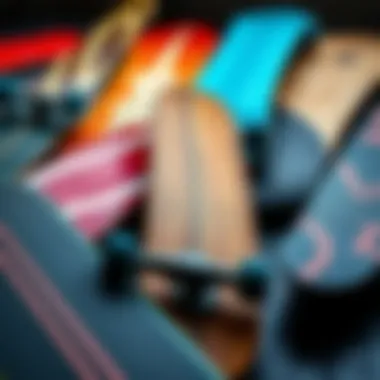The Ultimate Guide to Long Boards and Longboarding


Intro
Longboarding isn't just a pastime; it's a lifestyle deeply woven into the fabric of many communities around the world. As enthusiasts carve their paths down city streets, they aren't merely navigating from point A to point B — they are embracing a culture, an art form, and a sense of freedom that few activities can provide. This guide aims to unpack the essential elements of longboards, shedding light on their multifaceted designs, why different users gravitate towards specific types, and the underlying rules of construction.
Understanding longboarding involves more than just picking a board; it's about grasping the nuances of techniques, gear, and the community ethos driving it all. From the basic maneuvers that get newcomers rolling to the advanced tricks that seasoned riders thrive on, there’s a rich tapestry of skill development waiting to be explored.
Furthermore, safety remains paramount in this exhilarating sport. Knowing the gear you should don and the maintenance routines to follow can extend not only the lifespan of your board but also ensure a safer ride. Add to that the cultural depth and the friendships forged on this shared journey, and you have a compelling narrative that pulls you in.
In this article, we’ll navigate the liberating world of longboarding, providing insights tailored for skateboarders, parents, and retailers alike. Let's roll into the diverse techniques and essential gear necessary for a successful longboarding experience.
Skateboarding Techniques
Mastering the Basics
Before showcasing jaw-dropping tricks, one must master the fundamental techniques of longboarding. Starting with the basics sets a solid foundation, paving the way for more complex maneuvers. Here are some key elements:
- Stance: Finding your balance is crucial. Your front foot should be positioned securely on the board while your back foot kicks off to gain momentum.
- Pushing Off: With one foot on the board and the other pushing off the ground, initiate a smooth glide. Practice this until you feel comfortable.
- Turning: Learn to shift your weight while leaning slightly onto your toes or heels to steer the longboard. This is essential for navigating tight corners.
These basics form the stepping stones; they provide the confidence needed to tackle the open road.
Advanced Tricks and Stunts
After mastering the basics, the horizon of possibilities expands. For those ready to take their skills up a notch, here are some advanced tricks that can dazzle fellow riders:
- Carving: This involves rhythmically leaning into your turns, creating a smooth wave-like motion down a slope.
- Slide: Execute this by using your back foot to brake while drifting sideways. Mastering slides can help maintain speed and control on steep declines.
- Tricks like the Kickflip or Heelflip: Once comfortable with basic tricks, these flips add flair and tricks to your riding style.
Remember, practice makes perfect, and even seasoned pros continue to refine their skills.
Gear and Equipment
Skateboard Types and Features
Longboards come in various shapes and sizes, each designed for specific riding styles. Here are some to consider:
- Freeride Boards: Ideal for those who love to slide and perform tricks as they provide stability and control.
- Downhill Boards: Built for speed, these boards typically have a lower center of gravity and a sturdy design to handle higher speeds.
- Surf Skates: Mimicking the movements of surfing, these boards allow for deep carving and a unique ride experience.
Essential Safety Gear
Safety gear is non-negotiable. Investing in high-quality equipment can mean the difference between a minor mishap and serious injury. Essential safety gear includes:
- Helmet: A well-fitted helmet protects the head from impacts.
- Elbow and Knee Pads: These absorb shock and prevent scrapes during falls.
- Wrist Guards: They stabilize the wrists against the common risk of falls that lead to wrist injuries.
The right equipment ensures that your longboarding experience is both enjoyable and safe.
"The journey of a thousand miles begins with a single stepor in this case, a push off your longboard."
As we move forward into the cultural aspects of longboarding, community engagement, and maintenance tips, it is clear that this sport offers much more than just a mode of transport. It's an entryway into a lifestyle filled with camaraderie, thrill, and, most importantly, personal growth.
For further exploration of the world of longboarding, consider visiting resources like Wikipedia and community forums on Reddit for tips and shared experiences. Additionally, engaging with safety protocols from reputable sources like CDC can ensure your adventure on the board is both thrilling and safe.
Intro to Long Boards
Long boards have carved out a niche within the broader world of skating, merging elements of art and engineering, with a community that thrives on shared passion and adventure. While skateboards often conjure up images of tricks and flips, long boards offer a different rhythm—more about gliding, carving, and enjoying the scenic paths of life. This section aims to unfold the significance of long boards, focusing on their definition and historical evolution, to provide context for the various styles and components that will be explored later.
Defining Long Boards
A long board is distinguished from a standard skateboard mainly by its extended deck length, which typically ranges from 33 to 59 inches. This added length offers benefits like stability, making it ideal for a variety of riding styles, from cruising to downhill racing. To put it simply, the longer the board, the smoother the ride. In layman’s terms, if you’re tired of your old skateboard's constant wobbling at high speeds, it's time to look into a long board.
What's interesting is that long boards are not just for seasoned skaters. Newbies can hop on, feel less intimidated, and get a grip on basics faster. The broad range of shapes, flexes, and materials means there’s something for everyone. Whether you're a weekend wanderer or a distance commuter, the right long board can match your lifestyle with flair.
Historical Context
The history of long boards dates back to the 1950s when surfers in Hawaii brought a piece of the ocean onto the streets. They sought to replicate surfing's smoothness, using wooden planks as their boards. As they started attaching wheels to these planks, they probably didn’t realize they were onto something huge. This shift brought about a new way to skate and laid the groundwork for the longboard revolution that would come decades later.
By the late 1970s and early 1980s, long boards gained popularity in California, where downhill racing and cruising became modes of expression for thrill-seekers. As materials evolved, so did designs. The advent of lighter materials like fiberglass allowed for more innovative shapes and improved performance.
Today, longboarding is not merely a pastime; it has developed into a thriving subculture with its own set of styles, events, and communities. From leisurely rides along the beach to competitive events that see top riders pushing boundaries, the history of long boards is as rich as it is diverse.
"Longboarding connects people across geography; it’s not just about the board but the culture that comes with it."
Types of Long Boards


Understanding the various types of long boards is central to grasping the broader context of longboarding as a sport and lifestyle. Each type serves a specific purpose, catering to different skating styles and preferences. As longboarding evolves, so too do the designs and functionalities tailored to meet the needs of skaters. By diving into the distinct categories—cruisers, freeride boards, downhill boards, and carving boards—we can better appreciate the versatility and appeal of longboards. This section aims to shed light on what each type offers, helping enthusiasts make informed choices based on their skills and intended use.
Cruisers
Cruiser longboards are often characterized by their relaxed design and are ideal for casual rides. They typically feature a wider deck and softer wheels which provide comfort when gliding over cracks and bumps on the pavement. These boards excel in making short bursts around town or along bike paths, giving skaters the freedom to explore without the pressure of speed.
The significance of cruisers lies in their accessibility. Beginners find them friendly, given their stability and easy maneuverability. Moreover, the aesthetic appeal of cruisers often draws users in—designs range from minimalist patterns to striking colors that can showcase personal flair. Here are a few key points about cruisers:
- Deck Size: Generally wide, allowing for comfortable foot placement.
- Wheels: Softer and larger wheels absorb shocks, providing a smoother ride.
- Usage: Perfect for commuting, leisurely rides, or simply enjoying a sunny day.
Freeride Boards
Freeride boards are designed for those who crave the thrill of sliding and tricks while maintaining full control. These boards usually have a symmetrical shape, enabling tricks that can be performed both ways. Typically, they offer a stiffer build which provides the responsiveness needed for executing slides and sharp turns.
Freeriding is not just about speed; it's about mastering the art of balance and technique. Riders learn to shift their weight, initiating slides through subtle movements. Therefore, a solid understanding of one's own physical limits is crucial when selecting this type of board. Some noteworthy features include:
- Shape: Often symmetrical and lightweight for swift maneuverability.
- Flexibility: Stiffer decks for better control during slides.
- Tricks: Suitable for performing tricks such as the 180 slide and stand-up slides.
Downhill Boards
For those who seek adrenaline, downhill boards are the way to go. Built specifically for speed, these longboards feature a longer wheelbase and a narrower width which enhance stability at high velocities. Riders can expect a thrilling ride, but safety and technique become paramount when downhill riding.
These boards often include features that help with aerodynamics, ensuring that riders can cut through the wind as they race downhill. When it comes to selecting a downhill board, consider:
- Durability: Built to withstand high speeds and potential impacts.
- Weight Distribution: Typically heavier to stabilize when hurtling downhill.
- Take precautions: Wearing proper safety gear is non-negotiable due to the risks involved.
Carving Boards
Carving boards are all about the art of making smooth, rhythmic turns. They are designed for skaters who enjoy the feeling of carving through corners much like a surfer riding waves. Preferred for their agility, they typically feature a concave deck that allows for better foot positioning and grip.
The essence of carving lies in the fluidity of motion; riders learn to shift their weight back and forth, creating a dynamic riding experience. Carving boards are ideal for those who appreciate the dance between rider and board and want to enjoy scenic rides. Key characteristics of carving boards include:
- Concave Deck: Provides better grip and foot placement during turns.
- Flexibility: Flexible boards allow for easier turn initiation.
- Fun Factor: Ideal for recreational rides and creating stylish maneuvers.
"Selecting the right longboard type is crucial for an enjoyable experience. The diversity among boards means that there is something for everyone, whether they are just starting out or looking for their next challenge."
By recognizing these distinct types of longboards, skaters can tailor their choices to maximize their enjoyment and skill development within this thrilling sport.
Components of a Long Board
Understanding the components of a long board is not just a matter of personal preference; it's about getting to know the very heart of the longboarding experience. Every aspect of these boards can dramatically influence performance, handling, and overall enjoyment. From the shape of the deck to the mechanics of trucks and wheels, each component plays a vital role that can cater to different riding styles and environments.
Deck Materials
The deck is arguably the most significant part of any long board. It not only supports the rider but also determines how the board behaves under various riding conditions. Typically, long board decks are crafted from materials like maple, bamboo, or fiberglass.
- Maple: Known for its durability, Maple offers a solid base that can withstand wear and tear, making it a favorite among those who frequent tougher terrains.
- Bamboo: Light and flexible, bamboo boards provide a unique feel when cruising or carving. They absorb vibrations well, allowing for a smoother ride. If you’re one to enjoy long, leisurely rides, consider a bamboo deck.
- Fiberglass: Reinforces boards for enhanced rigidity without adding substantial weight. This material is often used in combination with wood layers to give riders the best of both worlds.
When selecting a deck, consider how each of these materials reacts to your riding style. Each type offers unique benefits, so pay attention to your preferences. Longboards with concave shapes can improve grip and control, allowing you to execute sharp turns without feeling like you're about to slide off.
Trucks and Wheels
The trucks and wheels are the unsung heroes of longboarding, working together to ensure a seamless riding experience. The trucks, typically made from aluminum, connect the wheels to the deck while allowing for pivoting and maneuverability.
- Trucks: Wide trucks provide stability, which is perfect for downhill riding, whereas narrow trucks are better suited for tricks and sharper turns. When figuring out thrust, the geometry is crucial as well. Look for adjustable bases that let you tweak the angles according to your comfort and need.
- Wheels: The wheel size and hardness can change the entire ride, too. Softer wheels (78A-87A) grip well on rough surfaces and provide a smoother ride, beneficial for cruising. Harder wheels (above 88A) glide better on smooth pavements, making them ideal for tricks and speed.
"Choosing the right trucks and wheels can elevate your longboarding experience, bringing comfort and performance right to your feet."
Conclusion: All components of a long board work in harmony to give riders a comprehensive experience. Understanding the ins and outs of each part encourages better decision-making when it comes to purchasing a board. For those who ride frequently, knowledge about deck materials, trucks, and wheels is paramount. It not only affects your ride but reflects your personal style and preferences as well.
Choosing the Right Long Board
Selecting the right long board is like finding the perfect pair of shoes; it can make all the difference in the experience. The choice hinges on various factors including individual skill level, intended use, and personal preferences. Understanding these elements is crucial for not only enjoying the sport of longboarding but also ensuring safety and achieving the desired performance. This section aims to guide beginners and seasoned riders alike through the intricacies of choosing the right long board.
Skill Level Considerations
When it comes to longboarding, your skill level plays a major role in selecting the right board. Beginners may feel overwhelmed by the options, but focusing on a few key aspects can simplify the process.
- Stability vs. Agility: New riders often benefit from a stable board that allows for easier balance and control. Look for wider decks and softer wheels which provide a smoother ride. On the other hand, more advanced riders might prefer narrower boards designed for tricks or carving, allowing for sharp turns and greater maneuverability.
- Weight Limitations: It's important to consider the weight capacity of a long board, particularly for heavier riders. Boards come in different thickness and material compositions, each with varying durability. For instance, heavier riders might opt for a sturdy bamboo or maple deck.
- Learning Curve: If you are just starting out, consider a board designed specifically for learning. Soft wheels and flexy decks can absorb shocks from uneven surfaces, providing a gentle introduction to the sport.
"The right longboard can make you feel like you’re gliding on air, while the wrong one can leave you feeling like you’re struggling up a rocky mountain!"
Intended Use


Your preferred style of longboarding is another significant factor when choosing the right board. There are boards specifically tailored to various uses, each with its advantages.
- Cruising: If you're looking for a laid-back ride to navigate through town, a cruiser could be your best bet. Wider trucks and larger wheels ensure a comfortable session, letting you glide over bumps and cracks with ease.
- Freeride: For those interested in performing slides and tricks while maintaining control, a freeride board is ideal. It generally features a symmetrical design which offers a twin tip shape, making it versatile for riders who often switch stances.
- Downhill Riding: If your heart races at the thought of descending steep hills at high speeds, look for a downhill board. These boards are typically stiffer and provide superior stability. They often come with wheel sizes that maximize grip without compromising speed.
- Carving: Carving boards are perfect for those wanting to mimic a surf-like experience on the pavement. Their narrow decks and responsive trucks allow for fluid turns.
Safety and Maintenance
Safety and maintenance are fundamental aspects of longboarding that every rider must prioritize. Neglecting these elements not only jeopardizes the safety of the individual rider but can also affect the overall longboarding experience. Whether you're a seasoned veteran or a newcomer to the longboarding scene, understanding the role of safety gear and regular maintenance is essential to enjoy the sport to its fullest.
Safety Gear Recommendations
When it comes to longboarding, wearing the right safety gear can be a game changer. Here are some essentials that any rider should consider:
- Helmet: A good helmet is non-negotiable. Look for a model that meets safety standards, such as CPSC or ASTM. A fitted helmet can prevent serious injuries in case of a fall.
- Wrist Guards: Often overlooked, wrist guards can save you from fractures and sprains, especially when learning new tricks or riding downhill.
- Knee and Elbow Pads: These pads provide an extra layer of protection against scrapes and bruises. They allow for greater confidence while tacking tricky spots.
- Slide Gloves: For those who enjoy freeriding, slide gloves provide the grip necessary to maintain control during slides while protecting your hands.
"Investing in safety gear is investing in your longboarding journey. It opens up a world of confidence to push limits."
Each piece of gear serves a purpose and is a small investment compared to the cost of potential injuries. Make sure to find gear that fits well and is comfortable to wear.
Regular Maintenance Practices
Proper maintenance is pivotal in keeping your longboard in prime condition. It enhances performance and prolongs the lifespan of your board. Here are some important practices to undertaking regular maintenance:
- Deck Inspection: Check the deck for any cracks or signs of wear. If you notice any damage, it may be time for repair or replacement. Cleaning the deck regularly can also prevent dirt buildup that may affect grip.
- Truck Tightening: Over time, bolts can loosen due to the vibrations of riding. Make sure to check and tighten the truck bolts periodically to ensure optimal performance and safety.
- Wheel Check: Inspect wheels for uneven wear or damage. Rotate them if necessary to ensure even wear and better performance. Look out for dirt or debris stuck in the wheel bearing and clean them to maintain a smooth ride.
- Bearing Maintenance: Clean the bearings regularly, as dirt and grime can slow down your ride. Removing the bearings and using a cleaning solution, followed by lubrication, can help keep them spinning smoothly.
Incorporating these practices into your longboarding routine is akin to routine maintenance on a vehicle; it keeps everything functioning harmoniously.
For more in-depth resources about safety and maintenance in skateboarding, you can check out Wikipedia on Skateboarding and related forums on Reddit.
Prioritize your safety gear and maintenance routine to ensure a safe, thrilling, and enjoyable longboarding experience.
Longboarding Techniques
Longboarding isn't just about having a sweet ride and gliding on the streets. It involves a set of techniques that can significantly enhance the overall riding experience. Understanding longboarding techniques is crucial not only for safety but also for fostering a deeper connection with the sport. Riders of all skill levels can tap into a wealth of knowledge that enhances their competencies and enjoyment. This section will unpack various techniques by highlighting the fundamentals and introducing more complex maneuvers.
Basic Riding Techniques
When newcomers step onto a longboard for the first time, having a grasp of the basic riding techniques can make all the difference. Mastering these fundamentals not only builds confidence but also ensures safety while on the road.
One notable technique is the push. Riders can use their back foot to propel the board forward while balancing on it with their front foot. This is the most common way to start moving. When pushing, the ideal is to keep the board steady and lean slightly forward to maintain balance.
The next step is learning to carve, which involves turning smoothly from side to side. Carving is essential for maintaining control, especially when cruising downhill. To carve effectively, a rider leans into the turn by shifting their weight in the direction they want to go. As they gain experience, they'll become more fluid, and carving can feel almost like dancing on the board.
Equally important is the ability to brake. Proper braking techniques prevent unwanted accidents, especially when descending. Riders should practice the foot brake, which involves placing the back foot on the ground while keeping the weight centered on the board. Another useful method is the slide brake, where the rider performs a slide to slow down. This technique is more advanced and requires practice but can look impressive once mastered.
Advanced Tricks and Stunts
Stepping up from the basics, advanced tricks and stunts can offer a whole new level of excitement and showcase a rider's skills. These techniques add flair and can be quite rewarding, both in terms of personal satisfaction and community recognition.
One popular trick is the 360 shove-it, which involves the rider spinning the board underneath them while completing a full 360-degree turn. This trick combines balance and timing, making it a crowd-pleaser when executed well. To perform it, riders need solid foot placement and a good understanding of their board's movement.
Another dynamic maneuver is the nose manual, which involves balancing on the front wheels while lifting the back wheels off the ground. This requires great balance and concentration as riders must keep their weight steady. Learning to control the board during such balances can boost confidence immensely.
"Practicing stunts is all about repetition and gradually pushing your limits. It’s not just about impressing others; it’s about discovering your own capabilities."
Lastly, for those who crave adrenaline, the stand-up slide offers a thrilling experience. While it's a more advanced move, once learned, it allows riders to maintain control while braking. Riders will need to shift their weight efficiently while turning their shoulders, ensuring that the slide is smooth.
In both basic and advanced techniques, incorporating different elements of body movement and board control lays the foundation for a skilled longboarder. Not only do these techniques enhance one’s riding experience, but they also nurture a community of engaged and passionate longboard enthusiasts.
Relevant Resources
- For a deeper understanding of rider safety and techniques, visit Skate-Safety.org
- The community discussions and tips can be found on Reddit Longboarding and Facebook groups.
Longboarding Culture
Longboarding is not just a sport; it’s a lifestyle that brings people together. The culture surrounding longboarding reflects individual expression, camaraderie, and a sense of belonging that transcends mere riding. From the tricks on the pavement to sharing stories at local skate spots, these elements shape a vibrant community that celebrates both freedom and creativity.
The Community Aspect
The heart of longboarding lies in its community. Skate parks and streets serve as gathering places where riders of all ages and skill levels come together. Here, friendships blossom over shared passions. Local meetups often transition into lifelong bonds, as riders encourage one another, share tips, and sometimes even collaborate on art projects.
In many cities, there are dedicated longboarding groups on social platforms like Reddit and Facebook, where enthusiasts exchange ideas, organize events, and plan group rides. An important part of this connection is the inclusivity that the community fosters. Whether you’re a seasoned rider or someone just testing the waters, you’re welcomed with open arms.
Additionally, some riders take it upon themselves to give back to their communities. They volunteer for clean-up initiatives in their local skate parks or mentor younger riders, teaching them the ropes of balance and culture. This blend of altruism and sport further solidifies the ethos of longboarding culture.


Events and Competitions
Events and competitions play crucial roles in uniting the longboarding community while showcasing talent and pushing the boundaries of the sport. These gatherings take various forms, from informal local races to prestigious international competitions.
Prominent events like the Maryhill Festival of Speed attract riders worldwide who gather not just to compete, but to share their love for the sport. These competitions are typically characterized by thrilling downhill races, where participants reach incredible speeds, testing their skills and nerves.
Moreover, competitions often feature a mix of disciplines. Freestyle events, for instance, highlight a rider’s technical ability, pushing competitors to impress judges with creativity and style. On the other hand, downhill events focus on speed and control, where precision is key.
"The thrill of competing is not just about the trophy; it’s about the journey, the experiences we share, and the friendships we build along the way."
The social aspect of these events cannot be overlooked. They create a festival-like atmosphere where food, music, and camaraderie converge, reminding everyone that longboarding is as much about community as it is about the ride. Additionally, many events serve as platforms for brands to showcase innovative longboard products and connect with potential customers, further blending commerce with passion.
The integration of grassroots events promotes inclusivity. Community-run competitions invite local talent to participate, proving that you don’t need to be a pro to be recognized. All of these factors contribute to a rich culture that celebrates not just performance, but also the connections forged on the pavement.
Environmental Considerations
As our world continually faces environmental challenges, it's crucial to consider how even the most niche activities are interwoven with sustainability. Longboarding is no exception. Its impact can be seen in several ways—both positive and negative. This section emphasizes the vital aspects of environmental responsibility within the longboarding community and how these considerations can inform both production practices and consumer choices.
Sustainable Materials in Long Board Production
The materials used in the production of long boards have a significant role in ensuring sustainability. Traditionally, long boards have been made from materials like maple wood, which is not just resilient but also aesthetically pleasing. However, the heavy use of certain woods can lead to deforestation issues. Thus, manufacturers are increasingly looking for alternatives. Here are some effective sustainable materials making headway in this niche:
- Bamboo: This rapidly renewable resource grows back within a few years. It's lighter than traditional woods, and the natural flexibility offers good performance. It’s a win-win for the environment and the rider.
- Recycled Plastics: Some innovative brands have started utilizing recycled plastics for their longboard decks. Not only does this reduce waste, but it also offers unique designs and vibrant colors, appealing to younger riders.
- Cork: Cork stops come from the bark of cork trees, which can regrow after being harvested. This makes cork an eco-friendly option. Its light weight and shock absorption enhance performance.
By opting for long boards made with these materials, riders can support environmental sustainability while enjoying their passion. This approach speaks volumes about how the community is evolving to be more eco-conscious.
Reducing Carbon Footprint through Longboarding
Longboarding, by nature, is a relatively low-impact activity on the environment, especially compared to cars or motorcycles. It’s not just about the materials used in making the boards but also about how riding a long board fits into a more sustainable lifestyle. There are several facets to this:
- Alternative Transport: Longboarding offers a carbon-free means of traveling short distances. Instead of hopping into a car for errands or commuting short distances, longboarders help reduce traffic congestion and lower greenhouse gas emissions.
- Health Benefits: Riding a longboard promotes physical fitness. Skateboarders tend to lead healthier lives, which in turn can lead to lower healthcare footprints on society. A fitter community means fewer resources are spent on health issues arising from sedentary lifestyles.
- Community Initiatives: Many longboarding communities actively engage in environmental preservation activities like park cleanups or promoting local bike lanes. These efforts help create environmentally friendly spaces that can be shared by everyone.
In this age of heightened environmental awareness, longboarding stands out as an opportunity to blend recreation with responsible living. By choosing to ride and support eco-friendly practices, longboarders actively participate in the broader effort to sustain our planet.
"Longboarding, in its essence, is not merely a sport; it can be a path toward a sustainable lifestyle, shaping a community committed to both thrills and environmental responsibility."
The interplay between longboarding and environmental considerations is undeniable. Embracing sustainable practices not only helps the planet but enriches the longboarding experience, making it appealing to future generations of riders.
Inspirational Longboarding Stories
The world of longboarding is rich with stories that not only inspire but also highlight the profound impact this sport can have on individuals and communities alike. These narratives, often filled with ambition, resilience, and camaraderie, serve as a beacon for both newcomers and seasoned riders. They reflect the spirit of adventure and the shared love for the open road, illustrating how longboarding transcends mere recreation to become a vital part of people's lives.
Prominent Figures in Longboarding
Among the figures who have taken longboarding beyond the streets and into the spotlight are athletes, innovators, and community leaders. One standout is Zach Miller, a professional longboarder who not only impacts the sport with his incredible tricks but also dedicates his time to teaching younger enthusiasts. His journey from a small-town boarder to competing in high-profile events serves as an inspiration, proving that passion combined with perseverance can lead to extraordinary accomplishments.
Another notable figure is Katy Duffy, renowned for promoting inclusivity within the longboarding community. She has initiated programs designed to bring together riders from diverse backgrounds, emphasizing the importance of unity and shared experience in longboarding. Her work shows that longboarding can be a great equalizer, creating bonds that may not exist outside its domain.
These figures not only represent skill and talent; they embody the values of commitment and community that resonate with so many in the sport.
Community Initiatives
Community initiatives play a crucial role in cultivating a thriving longboarding culture. Across the globe, local groups organize events that foster connection among riders. For example, the Longboard Girl Crew is a global initiative aimed specifically at encouraging female riders and creating a supportive environment for them. Their events not only promote skill development but also emphasize friendship and solidarity.
In cities like Santa Monica, weekly longboarding meet-ups have become a cherished tradition. Riders of all skill levels gather to share tips, showcase their latest tricks, and enjoy the thrill of riding together. It fosters a sense of belonging and a shared passion that amplifies the joy of longboarding.
Participating in these community-driven activities not only enhances one's skills but also builds lifelong friendships. These initiatives underscore the idea that longboarding is not just about the ride; it’s about the community that rallies around it.
"In the world of longboarding, stories connect us all; be it a slow cruise by the beach or an adrenaline-fueled descent down a mountain, every rider brings their narrative to the pavement."
Future Trends in Longboarding
Longboarding has been evolving rapidly, and understanding the future trends allows both enthusiasts and newcomers to stay ahead of the curve. Keeping an eye on these trends can enhance the longboarding experience and offer insights into how the sport will adapt to changing preferences and technologies. As we venture forward, we will explore two significant areas driving these trends: technological advances and shifts in popularity and style. Each section encapsulates the current trajectory and outlines how these changes can benefit skateboarders, retailers, and parents alike.
Technological Advances
As longboarding gains traction, we see a notable rise in technological advancements that are reshaping how boards are designed and manufactured.
- Smart Technology Integration: Modern longboards are increasingly incorporating smart technology. For instance, some boards now come equipped with sensors that track speed, distance, and even heart rate, giving riders a comprehensive view of their performance. These features not only help in monitoring progress but also in setting long-term goals.
- Innovative Materials: Another fascinating development is the shift towards eco-friendly and lightweight materials like bamboo, algae-based resins, and recycled plastics. Not only do these materials provide durability, but they also appeal to environmentally conscious consumers.
- Advanced Wheel Designs: The wheels are getting a makeover too. Attention to details like urethane compounds and geometrical designs mean better grip and shock absorption. This can greatly enhance the ride quality, making longboarding more enjoyable.
- Electric Longboards: Last but not least, we cannot ignore the surge in electric longboards. They are gaining popularity due to their convenience and the thrill they offer, especially in urban environments. Riders can now breeze through traffic or tackle steep hills with ease.
"The longboarding world is witnessing a tech revolution, where innovation meets adrenaline-fueled fun."
Shifts in Popularity and Style
The landscape of longboarding styles and preferences is also changing. People are beginning to recognize that longboarding is more than just a sport; it's a lifestyle. This shift brings both challenges and opportunities.
- From Streets to Parks: Once, longboarding was predominantly a street activity, but this is changing. Parks and designated longboard tracks are springing up, providing safer environments for riders to hone their skills.
- Diverse Riding Styles: There is no “one-size-fits-all” in longboarding anymore. Riders now have various options like cruising, downhill racing, and freestyle tricks. Each style appeals to different demographics, allowing more people to find their niche.
- Inclusivity in the Community: The appeal of longboarding is spreading across age groups and backgrounds, promoting an inclusive community. We're seeing more family-oriented longboarding events and initiatives that invite parents to join their kids in the fun, further enhancing the appeal of this sport.
- Fashion and Identity: Along with the sport’s growth, fashion trends related to longboarding are also evolving. Custom graphics on boards and stylish attire now serve as a way for riders to express their individuality and connect with like-minded individuals.
Embracing these shifts can help stakeholders in the longboarding community align their offerings with current consumer desires and societal trends. Staying informed about these ongoing changes is crucial for anyone keen on making a mark in the longboarding arena.















